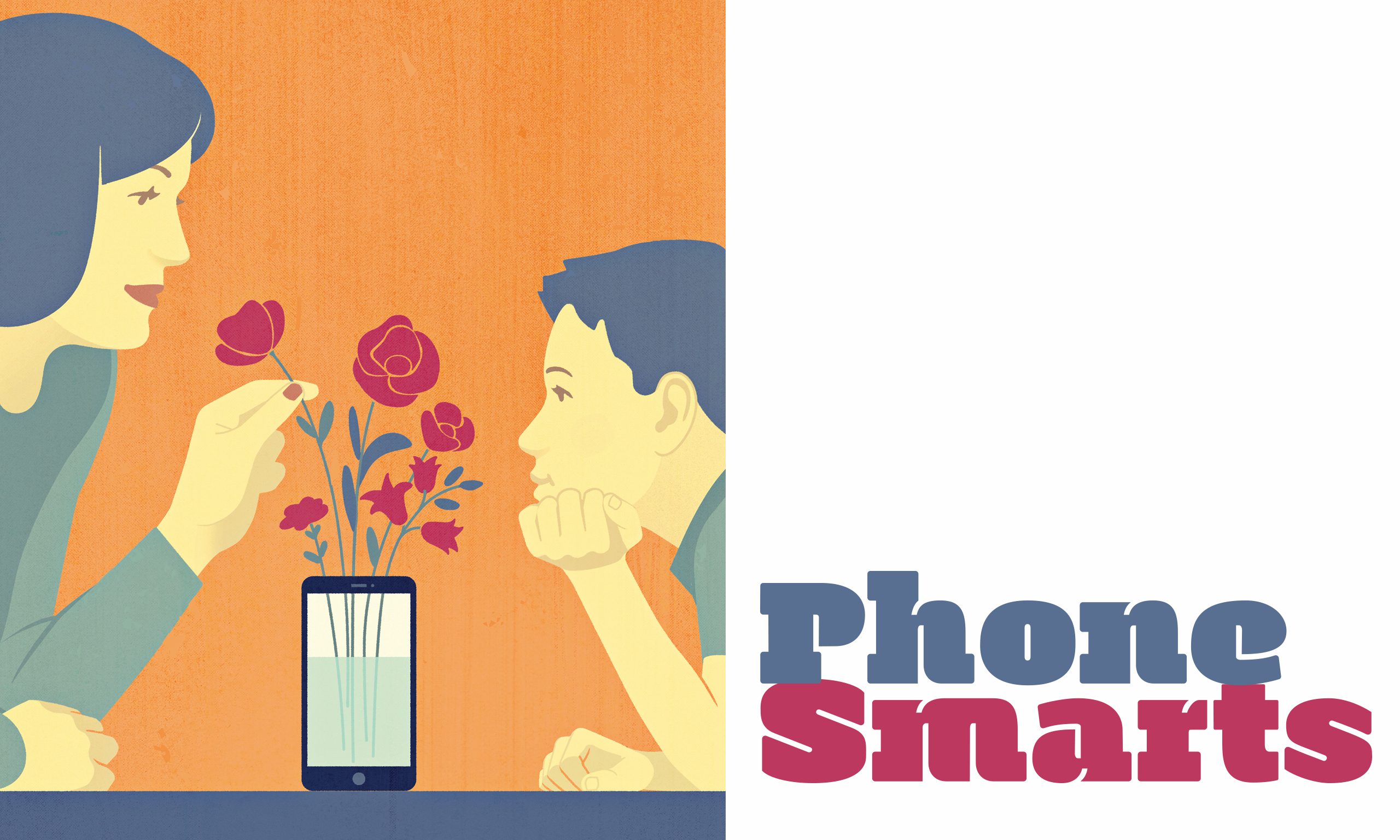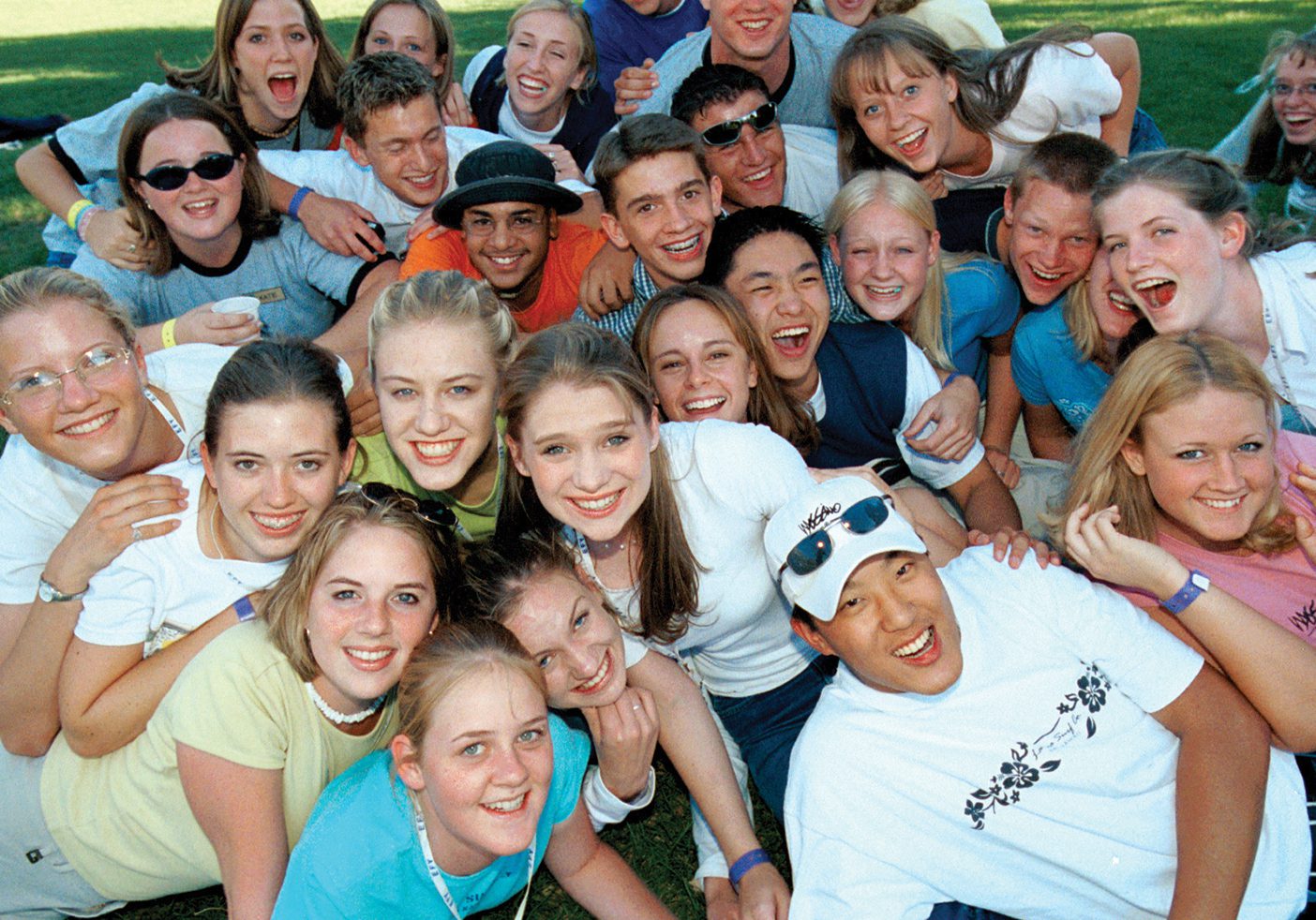Phone Smarts

Want to be a better device user? BYU experts say to focus more on how you use it and less on how much.
By Amanda K. Fronk (BA ’10, MA ’14) in the Winter 2020 Issue
Illustration by Joey Guidone
You’ve been there: gathered around a table with a group of friends or family, ostensibly for some face-to-face building of relationships. But within minutes, phones find their way into hands and eyes turn toward Instagram feeds, texts, and memes. Conversations and laughter dissipate, and what remains is the odd loneliness of being physically with people but mentally worlds apart.
For all their ability to make connections across the globe, smartphones have done a lot of isolating. And their harm goes further—phones have trained us to be masterful time wasters, chronically poor sleepers, and accident-prone drivers. That’s not to mention the ills of sexting, cyberbullying, and pornography or the rise in anxiety and depression.
It’s enough to make you want to take a sledgehammer to your phone.
But family-life professor Sarah M. Coyne, who has extensively studied the effects of new technologies on society, says the picture is more complicated than that. Her most-recent research came to the unexpected conclusion that the amount of time looking at social media on our devices—even if it is hours and hours—had no effect on levels of anxiety and depression. “When we really dug into the literature, it’s really not the time that you’re on it,” says Coyne. “It’s how you’re using it.”
All of us—adults and children alike—are new to this world of smartphones, trying to figure out how, when, and where they should be part of our lives. And the BYU experts stress that—if we can create healthy habits with smart devices—they should be part of our lives. “The vast majority of individuals can use media in . . . healthy and effective ways,” Coyne says, adding that, for everyone today, “learning how to effectively use a smartphone is an important skill.”
Left to Our Devices
There’s no doubt smartphones have changed the world. Today we can answer almost any question with a few taps on a screen. We carry the greatest musical hits from Bach to Beyoncé in our pockets. We can keep tabs on family and friends from coast to coast and from Scandinavia to Antarctica.
But careless smartphone use is also changing us, physically, mentally, and emotionally—mostly for the worse. The following are just some of the latest findings on how smart devices are affecting the way we live:
Brain drain. Those buzzes and vibrations that interrupt our workday? They’re leading to sloppier, less-focused work, according to research in the Journal of Experimental Psychology. And it’s not just notifications. A University of Texas study found that overall brain power decreased when a smart device was within view—even if the device was turned off.
Less sleep. Nearly 30 percent of teens fall asleep with devices in bed, and three-quarters of adults keep their phones within arm’s length at night. With phones providing melatonin-suppressing blue light and 3 a.m. notifications, it’s no wonder that 40 percent of us aren’t getting the recommended seven hours of z’s every night.

More pounds. Unsurprisingly, research has found that more smartphone use correlates with less physical activity. And one study found that users who were on their phones for five or more hours a day were 43 percent more likely to be obese.
Riskier roads. Today one out of every four car accidents is caused by a driver who was texting. Smartphone-distracted driving is six times more likely to cause an accident than drunk driving. More than 4,600 people were killed in 2018 in the United States in cell phone–related accidents.
Shallower social interactions. Research shows that when phones are present during face-to-face interactions—even when they are face down and not being used—there is a drop in feelings of closeness, connection, and conversation quality. That’s bad news because another recent study showed that 89 percent of research participants had used their phones during their last social interaction.
Smartphone Best Practices: Take Cues from the Missionaries
Now that many full-time missionaries have smartphones, the Church of Jesus Christ has provided guidelines for how to best use those devices. While some guidelines apply specifically to missionary work, most are wise practices for anyone with a phone.
Know your purpose. “Turn on your device only after your intention is clear. If you can’t remember why you are using your device, stop what you are doing and review your plans.”
Consider your feelings. “Limit the use of technology when you are feeling bored, lonely, angry, anxious, stressed, or tired, or when you feel any other emotion that makes you vulnerable or susceptible.”
Prioritize in-person interactions. “Avoid checking or responding to digital messages while you are talking with someone face-to-face.”
Don’t dodge direct conversations. “Avoid using your device as an excuse to avoid talking to people in person.”
How, Not How Much
In 2019 the average U.S. adult spent 3 hours and 43 minutes each day on a mobile device, surpassing TV usage (3 hours and 35 minutes) for the first time. A full 45 percent of American teenagers say they are on their phones “almost constantly,” according to a recent Pew Research Center survey.
And while such unbounded device use may sound like addiction, according to Laura Padilla-Walker, associate dean in the BYU College of Family, Home, and Social Sciences, “it’s around 10 percent” who have an actual addiction. For those few, adds information-systems professor James E. Gaskin (BS ’08, MISM ’08), addiction typically involves constant thoughts about being on the device, even when you have other responsibilities to focus on.
For the rest of us, however, the volume of usage may matter less to our well-being than the quality of the time spent on the device. In fact, experts still haven’t prescribed a set amount of smartphone time for adults or teens. And the results of Coyne’s eight-year longitudinal study of social-media use suggest that the amount of time has little to no connection to levels of anxiety and depression. “Two teenagers could use social media for exactly the same amount of time but may have vastly different outcomes as a result of the way they are using it,” Coyne says.
Gaskin, who studies the impact of different technology on people and work spaces, agrees: “Usually, [an increase in anxiety and depression] has more to do with the motivation behind the use” of smartphones than it does with the amount of time.
The professors say the adults and teens who struggle most are those who use devices to escape reality or who are highly affected by comparison (more on that below). And those who use phones for entertainment fare worse than those who use it for education or for connecting with others.
Healthy device use comes down to being intentional, says Coyne, or choosing to be an active rather than a passive user. Passive device use often involves a lot of scrolling. “That tends to be related to depression, anxiety,” she says. On the other hand, she notes that posting, making positive comments, and other active engagements “actually relate to decreased depressive symptoms.”

Intentional users turn on their phones with an objective in mind—like texting a friend details about an upcoming event, posting a picture of a family gathering, or looking up information on a topic of interest. Passive users, on the other hand, are more likely to open their phones for no reason or for the vague purpose of alleviating boredom. Cue the endless scrolling or hours of unplanned gaming.
Gaskin says a little introspection can help users determine the quality of their device time. “If every time you use it, you’re like, ‘Eh, my life isn’t that great,’ then you shouldn’t be using it or you’re using it wrong.” Here are some questions to ask:
• What have I been doing in the last 15 minutes?
• How have I been feeling? Anxious? Connected? Alone?
• Am I on here just because I’m bored?
• Have I intentionally been using my phone, or was I just passing time?
• Am I using my phone when I ought to be doing something else? During work? School? Sleep time?
Asking questions can also defuse another online land mine—unhealthy comparisons. With apps like Instagram full of seemingly picture-perfect lives, it’s common for users to feel that they or their lives are just not enough. Coyne likes the recommendation of psychologist Melissa Hansen Smith (BS ’97, PhD ’06), who advises users to hit pause any time they get stuck in a pit of comparison and to start asking questions: What’s her story? What things keep him up at night? What makes her cry? What things are really hard for this family?
“The reason why social comparison often happens is because we objectify people and ourselves,” says Coyne. “[Questioning] makes them a person, and then we’re far less likely to have that upward social comparison where the harm is.”
Smartphone Best Practices: Be a Proactive User
Give your smartphone a bedtime. “One of the most important things for adolescents is to get enough sleep, and device usage right before bed or during the night really interferes with that process,” says Coyne. She suggests both teens and adults turn phones off an hour before bedtime to help the mind wind down.
Set a timer. Tools like Android’s Digital Well-Being and Apple’s Screen Time can help track the amount of time we’re spending on any one app and enforce predetermined limits.
Practice self-care. Exercise, healthy eating, and adequate sleep are all important for overall mental health. Such self-care can also help with balancing our emotional relationship with devices.
Find other ways to combat boredom. Smartphones have become our go-to anytime we’re bored. Because smartphones provide passive entertainment, they have lower overall health returns than higher-energy leisure activities like taking a walk, reading a book, playing a sport, cooking, making a craft, or playing an instrument.
Turn off push notifications. A recent study out of Carnegie Mellon and Telefonica Research found that disabling smartphone notifications for as little as 24 hours improved concentration and reduced stress.
Make a phone-storage basket. “One of my colleagues has a basket . . . because [she and her spouse] noticed that they were spending too much time on their phones when they were with each other,” says Coyne.
Create a Phone Plan
Most kids turning 13 this year have never known a world without smartphones. Screens large and small have been an ever-present factor at home, in school, and in friendships. With technology playing such an outsize role in children’s lives, it’s key for parents to set parameters that help make it a blessing and not a curse. “The earlier parents can establish patterns of healthy media use, the better,” says Padilla-Walker.
A personal and household media plan can establish appropriate technological boundaries and promote positive habits for the whole family. Coyne recommends an easy-to-use customizable template created by the American Academy of Pediatrics (available at healthychildren.org/MediaUsePlan). Any plan should include
• Screen-free areas (like the bedroom, car, or dinner table)
• Screen-free times (like while doing work or homework, before bedtime, or while driving)
• Screen turnoff times (including designating when and where phones are charged)
• Rules on how devices should be used (like which websites and apps are appropriate to use)
• Device types for different ages (like a flip phone or a Gizmo watch or a full smartphone) and age-appropriate limits on access
“It’s going to look different for every family, but the point is you get talking,” says Coyne. The children’s participation is key. “If you help them be part of the conversation and . . . if they come up with [the plan], then they’re more likely to buy into it,” she says. “And then there’s less, ‘Here are the rules. You will obey me.’ That never goes well.”
She adds that “understanding how to use media is developmental. What often happens is we give our kids technological devices before they’re developmentally ready for them.” Instead, a family media plan should begin with age-appropriate media and change as children grow and learn.

Gaskin started simple in his home: His children—ages 14, 12, 10, and 6—all “share a kid phone, which stays at home unless they’re out babysitting or something,” he says. “It doesn’t belong to any of them.” Limited devices like the Gizmo watch, which allows the user to call or text only 10 people, or a flip phone that doesn’t provide access to the internet can be good stepping-stones to more immersive devices.
Padilla-Walker recommends putting off “giving your child a smartphone and access to social media for as long as possible.” She used maturity and interest as her guideposts with her own children, noting their individual levels of responsibility, openness, trustworthiness, and self-confidence. As children and teens show higher levels of these characteristics, they may be ready for more access to and autonomy with devices.

Granting children more and more technological autonomy should be a goal as children mature and prepare to live independently. While autonomy-restrictive parenting, where rules are dictated by parents, may be appropriate for younger children, autonomy-supportive parenting can help older children learn to self-regulate and make decisions with the help of their parents.
“The more autonomy you [gradually] give your kids and the more opportunity to regulate themselves, the better the final outcome will be,” says Coyne. Some teens may need a heavier hand than others when it comes to rules, particularly if they have struggled with such behaviors as sexting or viewing pornography, but most do well when they are granted the autonomy to work through concerns with their parents.
“Parents should be a really safe place . . . for kids to ask questions,” says Coyne, adding that parents should proactively talk through different potential situations with their kids—what she calls “pre-arming.” For example, parents can ask their children what they would do if they saw someone engaging in cyberbullying. Or if a pornographic image came up on their screen. And, says Coyne, parents can use these conversations to assure their children: “Hey, you can come and tell me when that happens, and I’m not going to get mad. I’m not going to steal your phone. I’m going to help you through this. . . . I’m your safe person, and you can come to me.”
Smartphone Best Practices: Monitor Kids’ Usage
Create passwords only the parents know. Gaskin and his wife control the passwords to turn on family smart devices. “We have very clever children who crack the passwords constantly, so we have to change them regularly,” he says. “I think I finally hit on a password they won’t crack. It’s been good for at least six weeks now.”
Set timers. Gaskin typically sets a 30-minute time limit when his kids use a device. “It’s not that I don’t trust them on the device,” he says. “It’s that I don’t want them spending two hours staring at a screen unproductively.”
Stow the devices on shorter car trips. Instead of staring at a screen, kids can look out their windows and observe the world around them.
Practice what you preach. Children watch their parents closely and often follow their lead on device use. Gaskin says that parents with unhealthy smartphone habits tend to have children who also struggle.
Be present. “Technoference”—when technology interferes with relationships—can weaken parents’ connection with their kids and each other. In a 2018 study, Coyne found that more than three-quarters of teenagers say that their parents regularly ignore them in favor of a device. “Those same kids feel less connected to their parents,” says Coyne. “They feel like their parents are less warm and responsive to them, which is related to a host of negative outcomes.”
Remember, It’s a Blessing
Despite his cautions to users regarding technological pitfalls, Gaskin is no Luddite. In fact, his campus office overflows with smart technology—from a little desktop robot to a temple-model-making 3-D printer. He wears a sleek black ring with a circuit-board interior. “It tracks my health and sleep and my heart and all my movement,” he says. “It Bluetooths to my watch and my phone.”
“There are tremendous benefits to technology,” he says. It’s just a matter of harnessing the devices in our lives for our good and for the good of others.
Coyne’s research has found that when parents and children use technology together, it can strengthen relationships. Even oft-maligned technological tools like social media can be put to good use when users are intentional. “Social media can have a powerful effect,” she says. “It gives you an opportunity to reach out and to connect with those who are really feeling down. [Or] if you’re feeling upset, . . . [then it’s] just another avenue to say, ‘Hey, I need some help.’ I’ve been in both those situations in the past.”
Padilla-Walker points to a quote from Elder David A. Bednar (BA ’76, MA ’77): “Technology in and of itself is neither inherently good nor bad. Rather, the purposes accomplished with and through technology are the ultimate indicators of goodness or badness.” She says our smart devices can do great good in our lives. “There are many blessings of recent technology, and within the correct limits, it can be used to further the Lord’s purposes,” Padilla-Walker says. “The challenge is finding the balance.”
Feedback: Send comments on this article to magazine@byu.edu.




